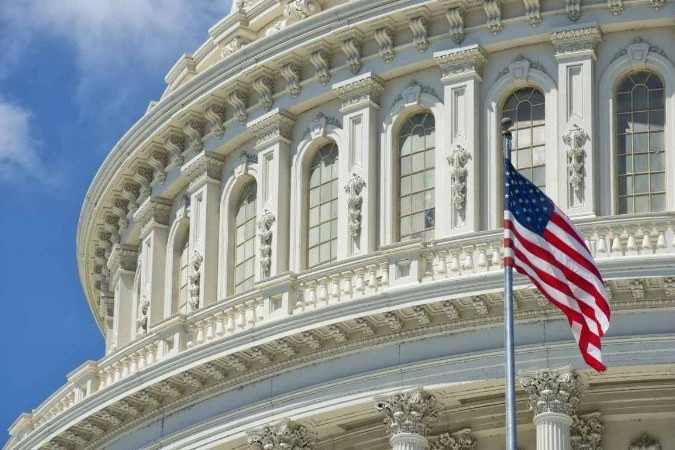The reasons and impacts for the US government facing its first shutdown in seven years
Ⅰ. Reason
1. The core trigger: The zero-sum game between the two parties over medical insurance subsidies
The disagreement over medical insurance policies has become the most direct trigger for this shutdown. The Democratic Party insists on extending the Affordable Care Act (Obamacare) subsidy, which was expanded during the pandemic, until 2026. This subsidy can keep the premium expenditure of middle - and low-income families within 8.5% of their annual income, covering over 15 million people. However, hardliners within the Republican Party firmly resisted on the grounds of "fiscal unsustainability", arguing that the "perpetuation" of such benefits would exacerbate the deficit. They even included provisions to cut Medicaid spending in the temporary appropriations bill.
The proposals from the two parties are in sharp opposition: The House Republican version of the temporary appropriations bill only keeps the government running until November 21 and does not include any provisions for extending health care subsidies. The Democratic version of the Senate explicitly ties the extension of subsidies to government funding and demands the revocation of previous cuts to Medicaid. In the Senate vote on September 30th, both parties' proposals were rejected as they failed to reach the 60-vote threshold, directly leading to a break in the capital chain.
2. Deep driving force: The spending battle under the burden of 37 trillion yuan in debt
This shutdown is deeply intertwined with the unprecedented debt crisis in the United States. As of 2025, the total federal government debt has exceeded 37 trillion US dollars, and the net interest expense in fiscal year 2024 reached 874 billion US dollars, surpassing defense spending for the first time. This vicious cycle of "debt-budget" forms a fatal closed loop:
The Republican Party's demand for cuts: In the face of the expansion of interest expenses, the Republican Party has made cutting spending on people's livelihood its core proposition, arguing that programs such as medical insurance and housing assistance "occupy fiscal space", and demanding that the pressure of debt repayment be alleviated by reducing benefits.
The Democratic Party's safeguard stance: The Democratic Party regards public welfare as the core basis of its votes and firmly opposes cuts in expenditures such as medical insurance and food stamps. Instead, it demands an increase in investment in social programs to address inflationary pressure.
Institutional contradictions: Under the dual constraints of the debt ceiling and budget approval, the two parties were unable to balance their revenue and expenditure through tax hikes (opposed by the Republicans), nor were they willing to compromise in their core interests, ultimately leading to a dead end.
3. Political Catalyst: The escalation of the game before the 2026 election
As the 2026 midterm elections draw near, both parties view this budget negotiation as a warm-up for their election campaigns, deliberately strengthening their positions to win over core voters. Hardliners of the Republican Party have attempted to consolidate the conservative base by using the label of "anti-welfare expansion". House Speaker Johnson publicly blamed the shutdown on the Democrats for "introducing irrelevant issues". The Democratic Party, on the other hand, is focusing on a "people's livelihood defense battle". Senate Leader Schumer accused the Republican Party of "using the livelihoods of federal employees as leverage" in an attempt to win the support of centrist voters.
This electoral logic has led to the complete disappearance of room for compromise. Although moderates within the Republican Party had proposed a compromise solution of "subsidy extension + fiscal trigger clause" (automatically tightening welfare if the deficit exceeded the limit), it failed to be advanced due to opposition from hardliners. The Democratic Party also refuses to accept the "patching" approach of "funding first and then negotiating", insisting on a "package solution".
4. Institutional flaws: The budget checks and balances mechanism has been distorted into a tool for party strife
The institutional design in the United States that a appropriation bill must be passed before the start of the fiscal year (October 1st), which was supposed to achieve checks and balances of power, has instead become a weapon of partisan strife amid the intensification of the opposition between the two parties. This shutdown has exposed the failure of three systems:
The failure of regular legislation: According to regulations, the government was supposed to pass 12 regular appropriation bills to ensure operation, but the two parties failed to reach a consensus on any one throughout the year, causing the negotiations to be delayed until the last minute.
The temporary plan has failed: The temporary appropriation bill was originally a "fire-fighting tool", but this time both parties have used it as a vehicle for policy games and attached a large number of ideological provisions, causing it to lose its "temporary" nature.
The communication mechanism broke down: The relationship between the White House and the congressional leadership dropped to rock bottom. Multiple key consultations were suddenly cancelled. The congressional recess in late September further shortened the negotiation time, leaving only a two or three-day window.
What is even more alarming is that this institutional alienation has become the norm - over the past half-century, the US government has shut down more than 20 times due to budget differences. This shutdown once again proves that "checks and balances" are becoming synonymous with "paralysis".

Ⅱ. Influence
1. People's livelihood and public services: Millions of families are under pressure, basic security has come to a standstill
Federal employee survival crisis
About 750,000 federal employees were forced to take unpaid leave, and hundreds of thousands of core position personnel (such as the military, border patrol officers, and air traffic controllers) had to "work without pay". The White House has clearly warned that "layoffs may occur soon". The Patent and Trademark Office of the US Department of Commerce has planned to cut 1% of its staff (about 140 people), and over 90% of the staff of the Securities and Exchange Commission have left their posts, with only 393 people retained to handle emergency matters. According to the estimation of the Congressional Budget Office, daily wage losses amount to as much as 400 million US dollars, and hundreds of thousands of families are at risk of defaulting on their mortgages and car loans.
Public services have come to a complete standstill
Transportation and travel: 11,000 employees of the Federal Aviation Administration are on leave, and 13,000 air traffic controllers are working without pay. Coupled with the original personnel shortage, airport security check queues have been prolonged and flight delays have soared. The East Coast hub has witnessed over 100 cancellations in a single day.
Tourism and research: Over 400 national parks have closed visitor centers and suspended garbage clearance. The Statue of Liberty may fall into "darkness" as the state government refuses to advance funds. The Smithsonian Institution Museum can only remain open until October 6th. The 32,000 employees of institutions such as the Centers for Disease Control and Prevention and the National Institutes of Health have taken leave, medical research has been disrupted, and the capacity to prevent the flu season has been weakened.
People's livelihood security: Food voucher applications and housing assistance approval have been suspended, and low-income families may face the risk of food shortage and homelessness. Delays in passport processing and drug approval have blocked cross-border travel and medical demands.
2. Economic shock: Double kill of data blindness and direct losses
Core economic data "cut off supply"
The Bureau of Labor Statistics has suspended the release of key data such as the non-farm payroll report and the consumer price index (CPI), and the statistical work of the Bureau of Economic Analysis and the Bureau of Census of the Ministry of Commerce has come to a standstill. This has led the Federal Reserve to lose its decision-making basis in the complex situation of "weak employment + stubborn inflation". The chief economist of Ernst & Young directly stated that this move is like "flying blindly in thick fog", and the October interest rate cut plan may be forced to be postponed.
Quantitative losses continue to expand
Direct losses: Ernst & Young predicts that the weekly economic loss will reach 7 billion US dollars. S&p points out that each week of shutdown will drag down the GDP growth rate by 0.1 to 0.2 percentage points. If it lasts for a month, the losses will exceed 28 billion US dollars.
Industry blow: The tourism industry is the first to be hit. National parks lose an average of 1 million US dollars in ticket revenue per day, and surrounding businesses lose 77 million US dollars per day. The aviation industry is losing over 500 million US dollars every week. The American Travel Association warns that "the longer the shutdown, the harder it will be to recover."
3. Politics and Institutions: The fierce battle between the two parties reveals the failure of governance
The deadlock of the party struggle remains unresolved
This shutdown originated from the differences between the two parties over medical insurance subsidies and spending on people's livelihood: the Democratic Party demanded the extension of medical insurance benefits for low-income groups, while the Republican Party insisted on cutting spending to deal with debt pressure. The proposals of both parties in the Senate were rejected, and they shirked responsibility from each other. As the 2026 midterm elections draw near, neither party has any intention of compromising, and the deadlock is unlikely to be broken in the short term.
The collapse of institutional credibility
Over the past half-century, the US government has shut down more than 20 times. This shutdown once again exposes the distortion of the "budget checks and balances" mechanism - from a tool for power supervision to a weapon for party strife. Aberdeen Investments of the UK pointed out that concerns over the "political failure" of the US have intensified. Although the sovereign credit rating has not been adjusted for the time being, it may affect the status of the US dollar in the long term.
4. Global impact: Disruptions in trade chains and market panic
International trade is blocked.
The leave of customs technicians has led to a 15% to 20% delay in the customs clearance of goods at the Port of Los Angeles and the Port of Long Beach, and the import of perishable food and medicine is at risk of spoilage. The suspension of import and export license approval, which caused wine traders to lose over a million US dollars in a single day during the 2018 shutdown, is likely to have an even greater impact this time.
Financial market turmoil
Risk aversion sentiment pushed the price of gold to $3,870 per ounce, with the Chicago Board of Trade Volatility Index (VIX) rising significantly. The US dollar index came under pressure and declined, dragging down the volatility of global US dollar assets. The European economy is the first to be hit. The EU estimates that if there is an eight-week shutdown, GDP will lose 16 billion euros, with German industrial exports being the most severely affected.
Disclaimer: The information published on this website comes from the internet, which does not mean that this website agrees with its views or confirms the authenticity of the content. Please pay attention to distinguish it. In addition, the products provided by our company are only used for scientific research. We are not responsible for the consequences of any improper use. If you are interested in our products, or have critical suggestions on our articles or are not completely satisfied with the products received, Please also contact us via Email :sales9@faithfulbio.com ; Our team is committed to ensuring the complete satisfaction of customers.



